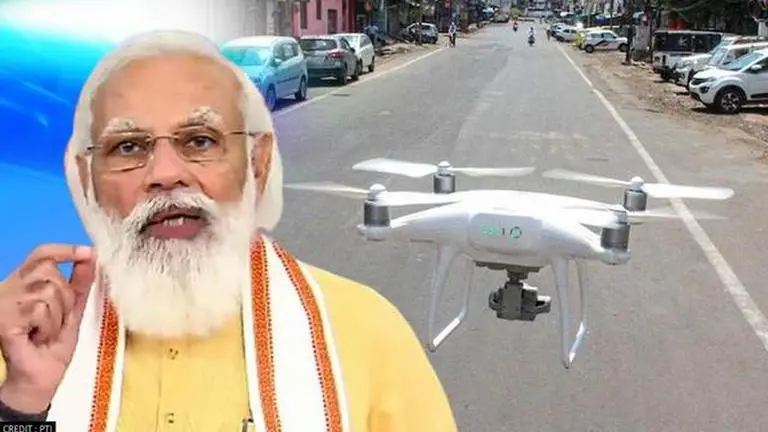Updated 27 August 2021 at 00:04 IST
New Drone Policy aims at USD 10 Billion, 5-lakh jobs, in a liberal progressive regime
PM Modi guides trust-based drone policy with reduced compliance burden aimed at attracting youth, business
- India News
- 4 min read

Cutting through bureaucratic caution, the Modi government announced a new drone policy that puts India in the league of the United States and China in terms of harnessing the new technology's potential in aid of the nation's development. Coming as it does in the wake of a terror strike at Jammu airbase, and a general spike in drone sightings across India's western border, the policy is being seen as a courageous statement of intent to put drones to productive use in education, research, commerce, and government sectors. Government sources are looking at the drone industry growing up to USD 10 billion and 5,00,000 jobs for the youth of the country over the next five years.
The new policy has the imprint of Prime Minister Narendra Modi’s thinking. “Trust-based governance, less government, reduction of compliance burden, end-to-end online solutions, and dealing with security challenges confidently are some of the guiding principles that the Prime Minister impresses upon in his policy interventions. We were guided by them,” informed a source, adding if we can’t be confident in our 75th year then when would we be? “This thought of the Prime Minister has got reflected in many other areas like space sector reform, subsidies reform, agriculture sector reform, and many other last-mile delivery schemes of the government,” said the source.
The new policy is based on three prongs of trust, self-certification, and non-intrusive monitoring with minimal procedural requirements. From an earlier framework that required up to 25 permissions and licenses, the new policy envisages only 5 permissions. Similarly, while the earlier fee structure had 72 heads, the users of drones would now need to pay only four or five times before being able to fly them. The entire process from purchase, licensing, training, and final usage has been made paperless and online. This is in stark contrast with the earlier policy that was brought out as late as January this year and was based on a restrictive, control-oriented licensing mechanism.
Sharing these details, Principal Scientific Advisor to the government, K VijayRaghavan, and Civil Aviation Secretary Pradeep Singh Kharola expressed hope that the tight rope walk that the government had sought to achieve between developmental needs and the security imperative would be met with the new framework.
Advertisement
Adequate security measures have been incorporated. For one, registration of drones means we immediately know the difference between a good drone and a rogue one. Two, as the drone industry matures, more security measures would be incorporated. Three, the security agencies would have access to all the data generated on the digital sky platform. As we get used to the system, safety features like 'No Permission, No Take Off (NPNT), real-time tracking beacon, geo-fencing would also get incorporated,” Raghavan said.
The policy introduces dynamic red, yellow, and green zones for the first time with electronic messaging to end-users notifying where they can fly their drones and where they cannot. The policy also institutionalizes drone training schools that would pass out registered drone pilots.
Advertisement
Overruling undue security concerns, Kharola said that all concerns have been taken care of. “The safest train is one which does not run, but then it does not take you anywhere. The immense potential of the drone technology to aid education and research, and general commerce cannot be ignored,” he said.
This confidence is reflected in the fact that the policy abolishes all approvals, replacing them with a registration that provides for a unique authorisation number, rest of the compliances largely self-certified. In yet another sign of pro-commerce tilt, the policy increases drone payload size to 500-kgs from the present limit of 300 kilograms. Ultimately, an Unmanned Aircraft Systems Promotion Council would also be set up to facilitate a further business-friendly environment.
(Image Credits: PTI)
Published By : Digital Desk
Published On: 27 August 2021 at 00:04 IST
